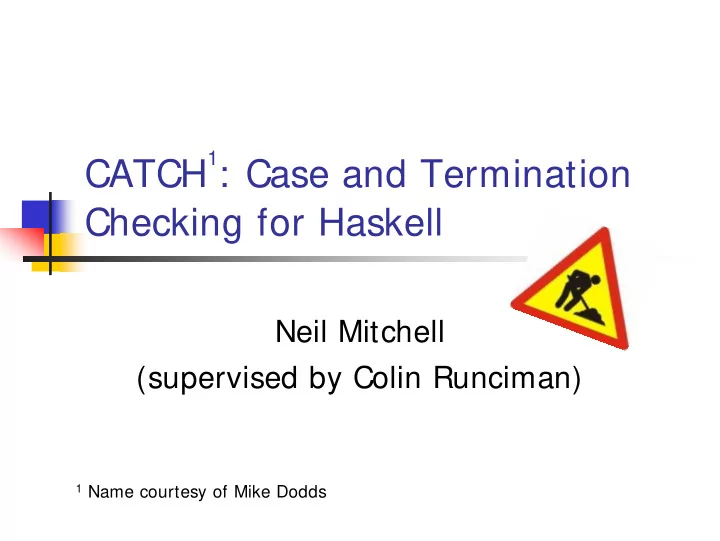

1 : Case and Termination CATCH Checking for Haskell Neil Mitchell (supervised by Colin Runciman) 1 Name courtesy of Mike Dodds
Termination Checkers Q) Does function f terminate? A) { Yes, Don’t know} � Typically look for decreasing size � Primitive recursive � Walther recursion � Size change termination
Does this terminate? f i b : : I nt eger - > I nt eger f i b( 1) = 1 f i b( 2) = 1 f i b( n) = f i b( n- 1) + f i b( n- 2) f i b( 0) = ⊥ NT
Remember the value! � A function only stops terminating when its given a value � Perhaps the question is wrong: Q) Given a function f and a value x , does f(x) terminate? Q) Given a function f , for what values of x does f(x) terminate?
But that’s wrong… f i b n | n <= 0 = er r or “ bad pr ogr am m er ! ” � A function should never non-terminate � It should give an helpful error message � There may be a few exceptions � But probably things that can’t be proved � i.e. A Turing machine simulator
CATC H : Haskell � Haskell is: � A functional programming language � Lazy – not strict � Only evaluates what is required � Lazy allows: � Infinite data structures
Productivity [ 1. . ] = [ 1, 2, 3, 4, 5, 6, . . . � Not terminating � But is productive � Always another element � Time to generate “next result” is always finite
The blame game is ⊥ NT � l ast [ 1. . ] � l ast is a useful function � [ 1. . ] is a useful value � Who is at fault? � The caller of l ast
A Lazy Termination Checker � All data/functions must be productive � Can easily encode termination i sTer m : : [ a] - > Bool i sTer m [ ] = Tr ue i sTer m ( x: xs) = i sTer m xs
NF, WHNF � Normal Form (NF) � Fully defined data structure � Possibly infinite � value{ * } � Weak Head Normal Form (WHNF) � Outer lump is a constructor � value{ ?} � value{ * } ⇒ value{ ?}
l ast x = case x of ( : ) - > case x. t l of [ ] - > x. hd ( : ) - > l ast x. t l (last x){ ?} = x{ []} v ( (x.tl{ :} v (x.hd{ ?} ) ^ (x.tl{ []} v (last x.tl){ ?} ) (last x){ ?} = x{ []} v x.tl{ []} v (last x.tl){ ?} = x{ []} v x.tl{ []} v x.tl.tl{ []} v … = ∃ i ∈ L(tl* ), x.i{ []} = x.tl ∃ { []} (last x){ * } = (last x){ ?} ^ (x{ []} v x.tl{ []} v (last x.tl){ * } ) = x.tl ∃ { []}
And the result: (last x){ * } = x{ * } ^ x.tl ∃ { []} � x is defined � x has a [], x is finite A nice result ☺
Ackermann’s Function dat a Nat = S Nat | Z ack Z n = S n ack ( S m ) Z = ack m ( S Z) ack ( S m ) ( S n) = ack m ( ack ( S m ) n) � (ack m n){ ?} = m.p ∃ { Z} ^ m{ * } ^ n{ * } � ack 1 ∞ = ? (answer is ∞ ) � ack ∞ 1 = ⊥ NT
Conclusion � What lazy termination might mean � Productivity � Constraints on arguments � WHNF vs NF � Lots to do! � Check it � Prove it � Implement it
Recommend
More recommend